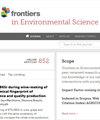中国经济复苏与环境治理的互动:能源消耗、二氧化碳排放与资源管理的综合分析
IF 3.3
3区 环境科学与生态学
Q2 ENVIRONMENTAL SCIENCES
引用次数: 0
摘要
为了深入了解中国能源消耗与经济增长之间的内在动态关系。本研究采用面板协整和因果关系模型,利用 SYS-GMM 技术,评估 2002 年至 2022 年中国绿色金融领域经济增长的影响因素。研究探讨了与中国经济背景相关的多个变量之间的相互作用,包括经济增长、二氧化碳排放、自然资源总租金、能源消耗和环境影响。在时间序列分析中,考虑了可能导致结构性扰动的关键因素。研究结果表明,这些变量之间存在长期协整关系,经济增长与自然资源租金总额、能源消耗、能源数量和生态足迹之间存在正相关关系。结果还显示,二氧化碳排放与能源消耗之间存在双向因果关系,能源消耗与 GDP 增长之间存在单向相关关系。此外,绿色金融支持的能源强度(EI)改善与二氧化碳排放量的显著减少有关,系数为-1.933(p &p;lt;0.05),凸显了技术创新的作用。进一步的评估表明,对可再生能源的投资可以促进经济增长、创造就业机会并减少温室气体排放。节能措施和绿色金融支持的技术创新在改善能源强度和减少二氧化碳排放方面发挥着至关重要的作用。本研究还强调了经济多样化对于减少对自然资源的依赖和提高经济稳定性的重要性。未来的研究应进一步探讨碳捕集与封存(CCS)等新兴技术的经济可行性和环境效益,为可持续能源实践提供更深入的见解。本文章由计算机程序翻译,如有差异,请以英文原文为准。
The interaction between China’s economic recovery and environmental governance: a comprehensive analysis of energy consumption, CO2 emissions, and resource management
To gain a deeper understanding of the intrinsic dynamic relationship between energy consumption and economic growth in China. This study employs panel cointegration and causality models, utilizing the SYS-GMM technique to assess the factors influencing economic growth in China’s green finance sector from 2002 to 2022. The research explores the interactions among multiple variables related to the Chinese economic context, including economic growth, carbon dioxide emissions, total natural resource rents, energy consumption, and environmental impact. While considering key factors that may cause structural disturbances in the time series analysis. The findings indicate the existence of long-term cointegration relationships among these variables, with positive correlations between economic growth and total natural resource rents, energy consumption, energy quantity, and ecological footprint. Results also show a bidirectional causal relationship between carbon dioxide emissions and energy consumption and a unidirectional correlation between energy consumption and GDP growth. Additionally, energy intensity (EI) improvements supported by green finance are linked to a significant reduction in CO2 emissions, with a coefficient of −1.933 (p < 0.05), underscoring the role of technological innovation. Further evaluations suggest that investments in renewable energy can promote economic growth, create job opportunities, and reduce greenhouse gas emissions. Energy-saving measures and green finance-supported technological innovations play crucial roles in improving energy intensity and reducing CO2 emissions. The study also underscores the importance of economic diversification to reduce dependence on natural resources and enhance economic stability. Future research should further explore the economic feasibility and environmental benefits of emerging technologies such as Carbon Capture and Storage (CCS), providing deeper insights into sustainable energy practices.
求助全文
通过发布文献求助,成功后即可免费获取论文全文。
去求助
来源期刊

Frontiers in Environmental Science
Environmental Science-General Environmental Science
CiteScore
4.50
自引率
8.70%
发文量
2276
审稿时长
12 weeks
期刊介绍:
Our natural world is experiencing a state of rapid change unprecedented in the presence of humans. The changes affect virtually all physical, chemical and biological systems on Earth. The interaction of these systems leads to tipping points, feedbacks and amplification of effects. In virtually all cases, the causes of environmental change can be traced to human activity through either direct interventions as a consequence of pollution, or through global warming from greenhouse case emissions. Well-formulated and internationally-relevant policies to mitigate the change, or adapt to the consequences, that will ensure our ability to thrive in the coming decades are badly needed. Without proper understanding of the processes involved, and deep understanding of the likely impacts of bad decisions or inaction, the security of food, water and energy is a risk. Left unchecked shortages of these basic commodities will lead to migration, global geopolitical tension and conflict. This represents the major challenge of our time. We are the first generation to appreciate the problem and we will be judged in future by our ability to determine and take the action necessary. Appropriate knowledge of the condition of our natural world, appreciation of the changes occurring, and predictions of how the future will develop are requisite to the definition and implementation of solutions.
Frontiers in Environmental Science publishes research at the cutting edge of knowledge of our natural world and its various intersections with society. It bridges between the identification and measurement of change, comprehension of the processes responsible, and the measures needed to reduce their impact. Its aim is to assist the formulation of policies, by offering sound scientific evidence on environmental science, that will lead to a more inhabitable and sustainable world for the generations to come.
 求助内容:
求助内容: 应助结果提醒方式:
应助结果提醒方式:


